Want to propagate fruit trees and shrubs but want to avoid seeds and pits? Well, there are 15 Fruits that Grow from Cuttings quite easily.
Want your backyard to be a personalized fruit market? Then, prune your favorite established fruit plant, gather its cuttings, and start multiplying.
Fruits that Grow from Cuttings
1. Blueberry
Botanical Name: Vaccinium
These blackish-blue, round fruits are desired for their intense tartness and sweetness. Either take a 4-6 inch softwood cutting late spring from the fresh tips of a healthy plant or pick strong, healthy twigs, also known as “hardwood cuttings,” late winter while the plant is dormant and place them in a pot with moist soil.
Blueberry cuttings take about 3-4 months to root, so patience is key. To ensure healthy growth, give it acidic, organic-rich soil, ample sunlight, consistent water, and rooting hormone. And once rooted, you can also grow it in pots.
2. Blackberry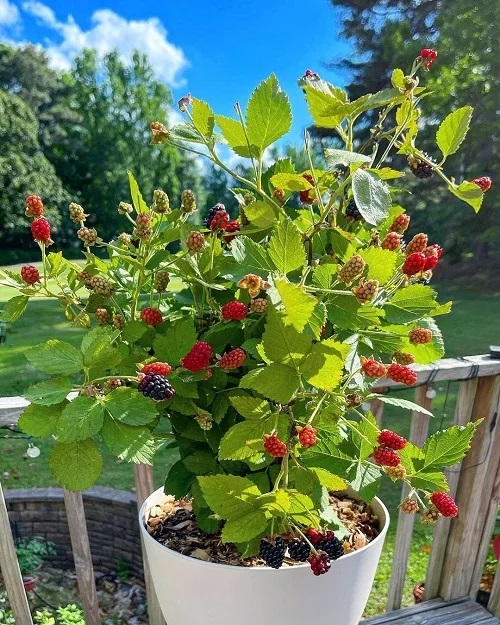
Botanical Name: Rubus
The sweet and tangy blackberry can be quickly spotted through its conical clusters of black and red fleshy fruit seeds. If you want to expand your harvest, multiply it by propagating it via leafy stem cuttings. Take semi-hardwood stems 4-6 inches long from a firm cane and stick them in a moist medium comprising peat and sand.
You can also use the abundant sprouts that shoot up from a mature plant to do the same. Just ensure they receive full dappled sun, and you’ll find roots sprouting in 3-4 weeks.
3. Currant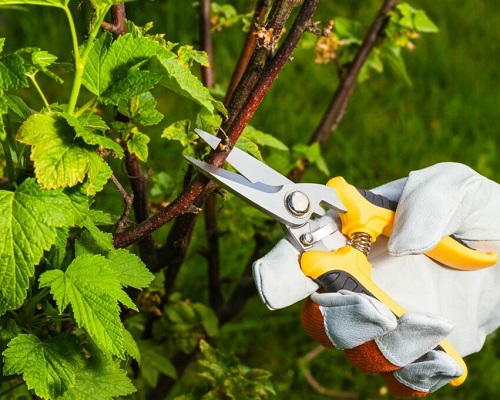
Botanical Name: Ribes
Currants produce bunches of tiny tarty berries used in jellies, wines and cooking. They grow well from cuttings taken at two different times of the year. Opt for soft, tender shoots during the growing season, anytime from late spring to early fall. Or go for hardier, woody stems from when the plant is inactive, around late autumn or early winter.
Plant 6-8 inches of sturdy cuttings together in one big tray or pot, and soon, you’ll have new transplants ready that you can plant and nurture into a specimen. Softwood cuttings take about 4-6 weeks to form roots, while the harder ones take about eight weeks.
4. Elderberry
Botanical Name: Sambucus
To have an unlimited supply of these dark, delicious fruits, grow them from stem cuttings. Between late winter and early spring, take a sturdy hardwood cutting and plant it about 3 inches in the soil. Give it a good misting regularly, and in 6-8 weeks, it’ll grow roots.
Elderberries thrive in full sun to partial shade and prefer well-drained, rich, loamy soil.
5. Mulberry
Botanical Name: Morus
If there is one fruit tree you should definitely grow in your garden, it’s mulberries, as they are always eaten fresh and have no shelf life. You can propagate them from hardwood cuttings in late fall or winter and from fresh, softwood cuttings in spring or summer.
The cuttings root quickly, and once rooted, baby plants need full sun and deep, thorough watering to establish well and yes, you can grow them in containers as well.
6. Fig

Botanical Name: Ficus carica
Tired of just berries on this list of fruits? Enter figs! These trees, with velvety textured fruits and jam-like flesh, can easily grow up to 15-30 feet tall and give you abundant harvests for years. As it grows best from hardwood growth, take 8-12 inches long stems from most mature and healthy branches in late winter or early spring to propagate.
Fig trees need moderate watering while growing but are pretty drought-tolerant once they mature. You can even grow them in pots!
7. Pomegranate
Botanical Name: Punica granatum
You can grow juicy Pomegranates from hardwood cuttings that are 8-9 inches long, taken in winter or spring. You can also propagate them from softwood cuttings, but this is not a successful method.
And do you know what the best part is? Pomegranates grown from cuttings keep the same characteristics as the parent plant. So, identify your favorite cultivar and take cuttings from it for unlimited homegrown, juicy, flavorful fruits.
8. Olive
Botanical Name: Olea europaea
The prized olive fruit can be propagated through semi-hardwood cuttings taken anytime between late summer and early autumn. Snip away a cutting about half an inch below a leaf node. Dip the cut end into a rooting hormone like honey and gently push it into a moist soil mixture.
But you’ll have to be patient for this one—rooting can take 8-12 weeks, so don’t give up.
9. Grapes
Botanical Name: Vitis vinifera
Grape vines are great for two reasons: they can be used to cover fences and arbors, and they produce delicious fruits. Around late winter or early spring, take many 12-18 inches long woody stems with at least four buds from dormant vines. Remember to place the cuttings on the right side up, or else they won’t root! In 3-4 weeks, roots will start to develop.
Once your cuttings have roots, transplant them to a spot with 6-8 hours of daily sun. Grapes need well-drained, loamy soil with rich organic matter.
10. Pineapple
Botanical Name: Ananas comosus
Everyone knows SpongeBob lives in a pineapple under the sea! So, the question is, did he build it from cuttings? Jokes apart, these sweet tropical delights won’t grow from cuttings but from the top of the fruit!
Chop off the top section with an inch of the fruit attached to it, let it dry for a couple of days, and plant it in well-drained sandy-loamy soil. Don’t forget to provide ample sunlight, and check out five more ways to grow them!
11. Rhubarb

Botanical Name: Rheum rhabarbarum
Well, Rhubarb isn’t technically a fruit but a tarty vegetable. You can grow it from its tops. Just like pineapples, plant its crown in rich, well-drained soil. Do this every few years to ensure robust plants and harvests.
When you cut off a piece for regeneration, reduce the leaf area by about 80% to prevent it from drying out. This one needs regular watering and full sun to partial shade.
12. Sea Buckthorn
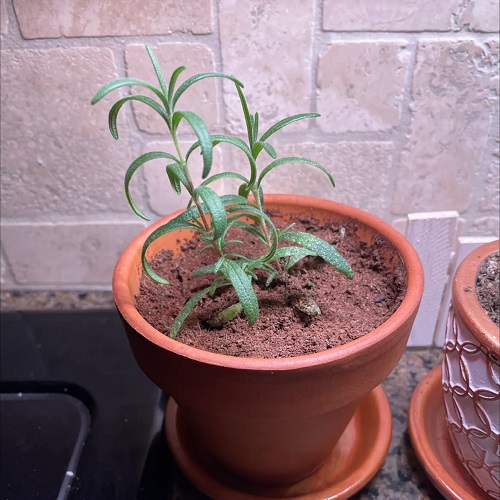
Botanical Name: Hippophae rhamnoides
The vitamin-replete tiny but mighty sea buckthorn is a lesser-known fruit you can grow from hardwood cuttings. Plant a 6-8 inch woody stem in sandy soil in those early spring months when the temperature’s just right.
These fruit cuttings root in 3-4 weeks under optimal conditions. Remember to provide it with ample sun for the tastiest berries!
13. Dragonfruit
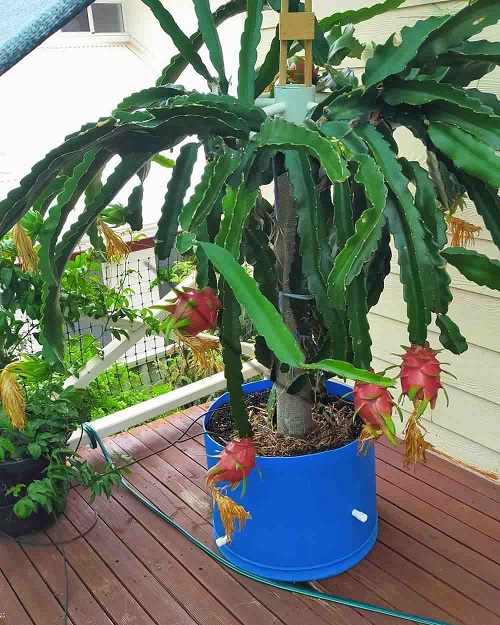
Botanical Name: Hylocereus
Also called pitaya, like the fruit of the Peruvian apple cactus, dragon fruits are quite unrelated. Sweet and tangy, you can enjoy extensive harvests from this climbing cacti by propagating it from its segments. Dragon fruit cuttings are typically 12-18 inches and must comprise several nodes to increase the success rate.
Allow the cutting to dry and callus over for at least 2-3 days to prevent rot. Plant in well-drained sandy soil and keep it in partial shade. The cuttings will start to root in 2-3 weeks.
14. Kiwi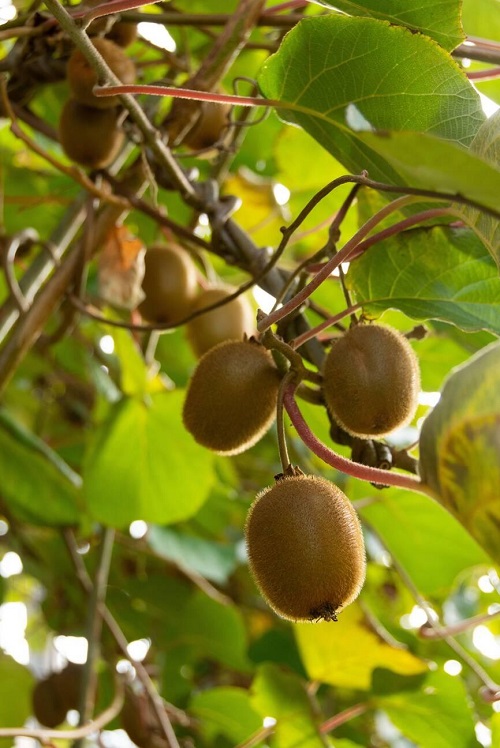
Botanical Name: Actinidia deliciosa
Kiwi vines are actually pretty great climbing plants with exquisite golden green fruits. And the best part is you can grow kiwis with just a simple stem cutting. Opt for a woody stem cutting in late winter or early spring, and if you’re late, identify fresh new growth to propagate it from softwood cutting in summer.
Preferring full sun to partial shade and well-drained fertile soil, your kiwi cuttings will sprout roots within 4-6 weeks.
15. Guava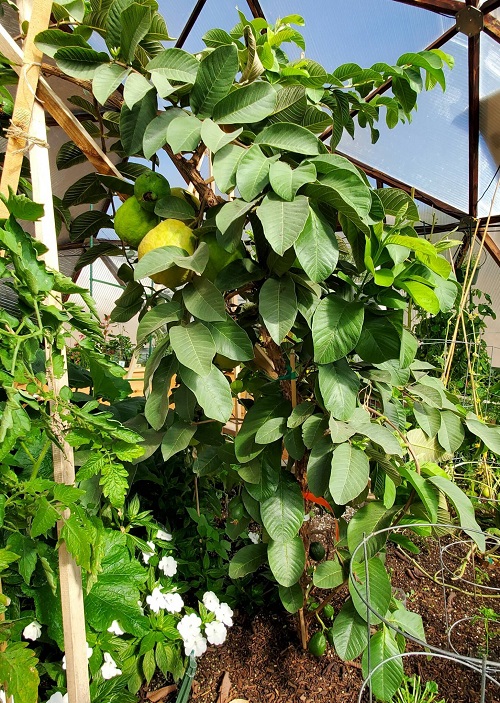
Botanical Name: Psidium guajava L.
Guavas aren’t just tasty tropical fruits; they’re surprisingly easy to multiply with cuttings. In spring or summer, take tender shoots from softwood about 6-8 inches long and pinch off the lower leaves, leaving just a few on top. Plant this little stem in a pot, keep it in a bright spot, and water it regularly.
In about a month, you’ll notice new roots and shoots growing from this–that’s your cue to move it to a bigger pot.


